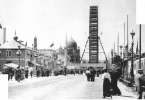The tulip delirium, the halwa (sweets) discussions, erecting candles on the backs of turtles and taking them on a stroll in the gardens at night, the establishment of the first Turkish printery, the establishment and undertaking of the first translation committee that could be evaluated as the initial efforts of an early enlightenment, the establishment of the first fire brigade unit called Waterpump Organisation (Tulumbacı Ocağı) under the Janissaries, the Sadabad entertainments, the beautiful women strolling on the sides of the marble silver paths, Nedim’s seductive voice, the translation of Ibn Haldun’s ‘Mukaddime’ by Pirizade Sahib Molla, the erection of public fountains in Istanbul, the admission of European-style furnitures and ornamentations within the palace and upper society, the efforts of Ibrahim Müteferrika – known to be a multi-talented man of science and culture -in establishing the printing house, the lenient fatwas (religious rulings) of Sheikhul-Islam Abdullah Efendi of Yenişehir, the golden images dripping from the extraordinary colours of Levni seen in ‘Surname’, the historical and valuable verses of Sümbülzade Vehbi, the success of settling the waves of unhappiness resulted by the uprising of Patrona Halil and the efforts of restoration of the state by Sultan Mahmud I, who ruled for 40 days although leading to a tragic end….
Istanbul was one of the stopover places where the tulip had rested during its journey from Central Asia to Holland. With its quality of plasticity, colour and our unique talent of developing the tulip, which intoxicates its onlookers with its colours, would also leave its traces indefinitely to the period we call ‘The Tulip Era’. Although it was an era of relaxation, enjoyment and entertainment, another deliriousness that would end up quite bloody was the Patrona Uprising and those events that followed it. Ariel Salzmann had described this uprising as the rebellion of the rose against the tulip.
On the other hand, the tulip is also called “the flower of pain”. Its colour is red due to the fact that the flames of love boiling within it is reflected on its outer facet. It is scorching like fire, and has suffered deeply, becoming wretched. Its heart is wounded and garments bloody. It is sorrowful. However, just like Arif Hikmet of Hersek had stated, it does not slash the bloody wound in the lover’s heart after a separation, but also leads the blossoming of the tulip of prosperity within the gardens of hope:
Nay! Thy heavy wound in thy bosom is not of separation
But thy hath blossomed the tulip of abundance in hope’s garden of rose
This era, which was spent in love, exaltation and cherishing of this flower, can also be expected to have had similar characteristics. Once you take a step back and examine the Tulip Era, the shiny garments may spellbind one. Yet, once you step inside, you will face a humane reality in wretchedness. Although we may have suspicions that during that very same period the following events were taking place – a curiosity towards halwa converses and magnets in Kağıthane were taking place, the story of the tulip called “Lü’lü-i ezrak” (the spear of fire) wrapping itself in the heat of thousands of gold melting, Europe’s machinery woven products eroding our market, the seductive gazelles of Nedim running to Istinye to listen to the chirpings of the nightingales, and the existence of the ‘Mem u Zin’ mysticism of Ahmed-i Hani, the clerk of the Ishak Pasha Palace in Dogubeyazit – sometimes, facing reality may hurt. But nevertheless, it ought to invite us to ponder about it.
Unfortunately, it will only be foolish to expect an education system of “do not think, just memorise” to reflect the Tulip Era with all of these contrasts. If we had not known that Charles Dickens’ words of “It was the best of times, it was the worst of times”, was not just the prologue to a novel but a preview applicable to all times, then our approach to history would always be an imprisonment into immaturity.
Just like other eras that nestled the good and the bad times within itself, the name of the Tulip Era, was one given together by a poet (Yahya Kemal) and a historian (Ahmed Refik) at the beginning of the 20th century. Those living during the times of the Tulip Era were in fact living within it without any knowledge! Just like it always is, the name was given afterwards.
Poetry, music, communion, the involvement of women in public life, the increase of wastefulness. The Çırağan nights, in which thousands of mussel shells would be lighted up with candles and left to sail in the waters of the Bosphorus… However, what happened in the backstages of this era?
For instance, why aren’t the incentives of the Ottoman administration for the local industry ever spoken of? Why was there a need for this? The reason for this was because the factory products of England and France would pass customs and affect the domestic market and lead to a crisis for the salesmen of the Grand Bazaar. Although its influence was limited, the first waves of the industrialisation of Europe were slowly being felt. In the face of this danger, Damat Ibrahim Pasha had initiated an incentive to the weavers and producers of glazed tiles and moreover, had even allocated the Tekfur Palace as a factory for this purpose.
On the other hand, an awakening in scientific activities can also be observed during the Tulip Era. As a matter of fact, Lady Montagu, the wife of the English Ambassador, writes in her letters of how the Turks had discovered the smallpox vaccination during the Tulip Era while the English were still ignorant about it.
Furthermore, we ought to also mention the establishment of the printery during this time and an inclination towards the concrete understanding of art as we have seen in the paintings of Levni. Another cultural blooming parallel to Ibrahim Müteferrika’s printery is the translation activities led by Damat Ibrahim Pasha, while the first person to have written about democracy in our culture was Müteferrika himself. Although the printery became active for a short time through the printing of books on topics of history, geography, dictionaries and mapps, these were all signs of a development within the Ottoman/Islamic world. We previously touched upon an inclination towards concrete art styles and one of the most striking examples of this can be seen at the Üsküdar Rabia Gülnuş Sultan Mosque. The mirror of the fountain built on the wall overlooking the main road is not stylised, but seems that the concrete fruits (including the bowl itself) has “deservedly” achieved its purpose. However, the more interesting aspect of this fountain is not the fact that the concrete object is not figured in a painting but instead engraved onto marble, depicting the movement of a knife lodged into a melon. As a result, while moving onto from a friut symbolizing heavens a freshening fruit of our daily lives, at the same time, the reflection of stressing the humane aspect with a depiction of movement onto marble resulted in the modern art of engraving.
Finally, the Tulip Era was one of changing shells, a transformation and the formation of an internal movement. The Tulip Era, just like the striking colours of a tulip hiding its inner self from gazes, has hidden its inner world from us and expects us to approach it calmly and attentively.









Leave a Comment